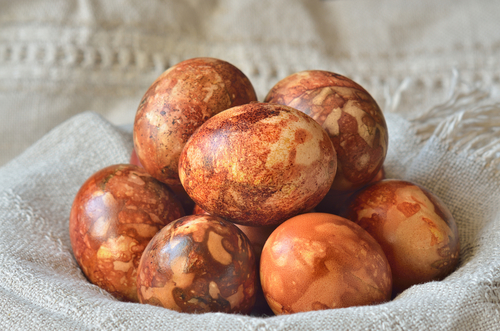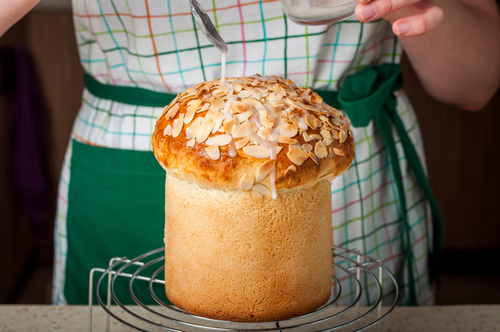Naturally Dyed Easter Eggs
Room temperature eggs:
For Red Eggs
skins of approx. 10 medium yellow skinned onions
5 cups of water
2 Tbsp. white vinegar
For Blue Eggs:
5 cups of finely chopped purple cabbage
5 cups of water
2 Tbsp. white vinegar

Read: Pysanka Festival in Kiev
Add your dry ingredients into a pot and pour enough water to cover them. Bring up to a boil and then simmer for 30 minutes. Take off the heat and allow it to cool down. Remove the purple cabbage or onions skins and place the eggs gently in the respective pot. Bring back to boil and simmer for 5 minutes, then take off the heat.
Allow the eggs to cool in the dye then transfer them to the fridge to set overnight.
Remove the eggs with a slotted spoon and allow to air-dry (for about 45 minutes). Dab a white paper towel into some vegetable oil and polish then place in the egg carton and store in the fridge until needed.
Want to make some other dyed eggs?
- use brown eggs with purple cabbage to get green eggs
- use brown eggs with yellow onions to get rusty red eggs
- use white eggs with shredded beets to get pink eggs
- use brown eggs with shredded beets to get maroon brown
Read: Orthodox Easter in Ukraine
Easter Bread (Paska or Kulich)
450 g of flour
1 cup raisins
220 g of softened butter
150 g of sugar
4 pcs. of egg yolks
2 pcs. of egg protein
1 pcs. of finely grated orange zest
20 g of fresh yeast
300 ml of milk
6-7 cardamom pods
1 tsp of vanilla
½ tsp of nutmeg
1 sachet of vanilla sugar
pinch of saffron
sea salt

Preheat the oven to 180 ° C. Soak saffron and raisins in water separately; break cardamom pods, remove seeds and grind them in a mortar with nutmeg, orange peel and vanilla sugar. Slightly warm up milk, pour away a half and dissolve the yeast in it, then add 150 g of sifted flour and knead the brew. Cover the bowl with a towel and leave it for 20 minutes. Warm up the remaining milk again, add 200 g of butter and wait until it dissolves. Beat three egg yolks with sugar; continuing to whisk, add milk and butter, then add pounded spices, vanilla and saffron filtered water. Add a bit of sieved flour to the brew and leave for another 15 minutes. Afterwards, add salt, yolk-milk mass and remaining flour. Stir it and leave the dough in a warm place for 2 hours.
Beat the egg protein with a pinch of salt. Add pressed raisins to the dough, knead well and carefully add the egg white little by little. Put the dough into the forms, greased with butter, and leave for 30 minutes to rest before baking. Bake small Paskas for around half an hour and the bigger ones for 45 minutes. Decorate the top when it is ready.
Read: Easter Symbols in Ukraine and Worldwide
Cream Cheese Paska
500 g of dry non-fat cottage cheese
100g candied fruits and dried fruits (papaya, melon, pineapple, cherries, cranberries, raisins, etc.)
90 g of butter
80 g of sugar
50 g of almonds
2 egg yolks
100 ml cream
1 vanilla pod

Mash cottage cheese through a sieve. Cut the vanilla pod, remove the beans and add to the cheese. Chop candied and dried fruits chop and mix them with crushed almonds. Beat butter with a fork or small whisk and add it to the dried fruit-nuts mix. Pour cream into a small saucepan and bring to a boil, but do not boil. Add there whipped egg yolks with sugar, stirring constantly, warm over low heat until the cream thickens, then remove from the heat and knead for 2-3 minutes. Mix all three ingredients you have. Cover the form with a double layer of cheesecloth and fill it with curd. Wrap the edges of the cloth crosswise, put with something heavy on the top of it and leave it for at least one day in the fridge.
Try out famous recipes for Orthodox Easter and enjoy the process of cooking. Bon appetit!







